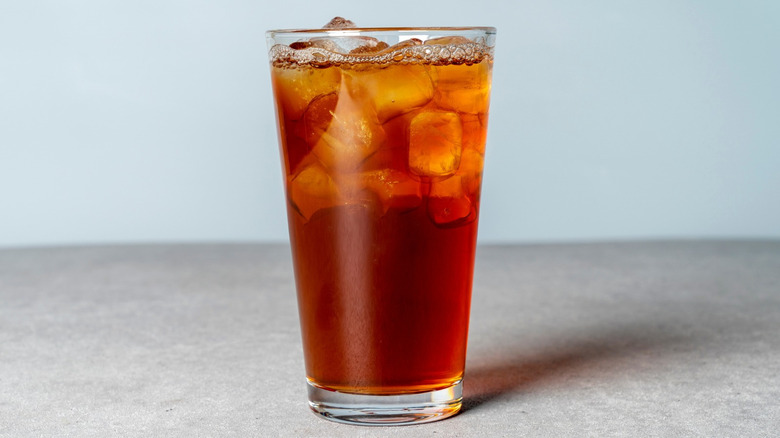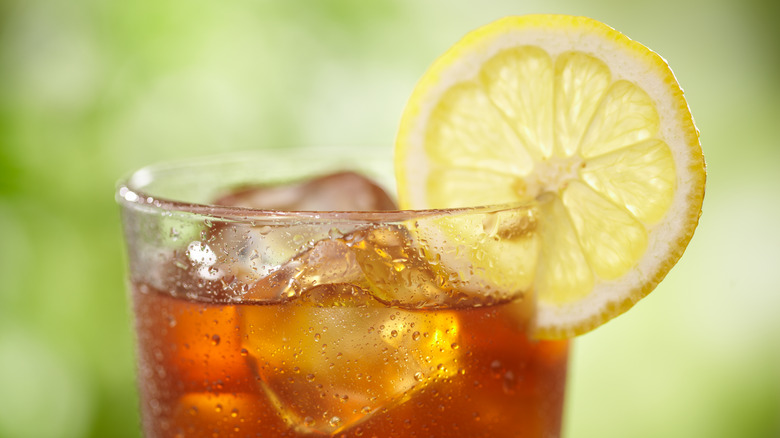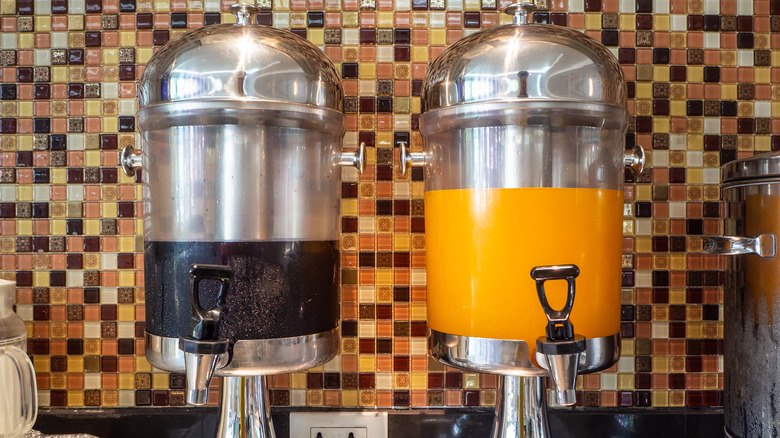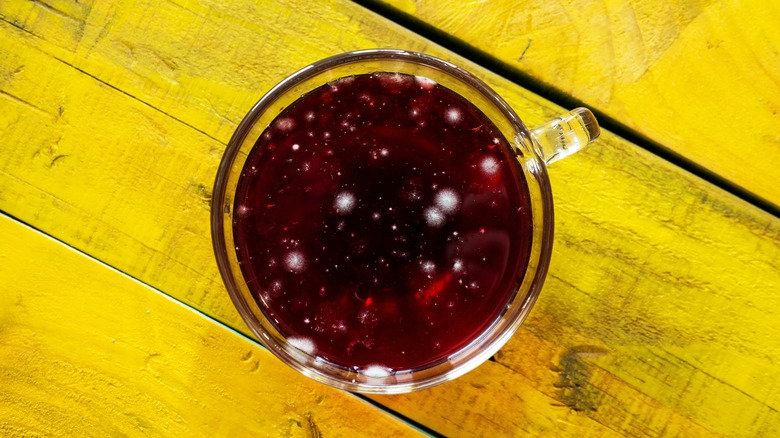The Shady Reason You Probably Shouldn't Order Iced Tea At Restaurants
Iced tea may seem like an innocent beverage order. After all, it's earned its spot on menus across the globe since iced tea first originated in 1879 and then was popularized at the 1904 World's Fair in St. Louis. However, beneath the crisp facade of this popular brewed drink lies a potential breeding ground for health hazards, primarily due to many restaurants' lack of cleaning protocol for the machines dispensing it. For this reason, you might want to opt for a different chilled libation at your local eatery.
Restaurants may typically aim to deliver a delightfully positive dining experience, but some may inadvertently be serving up more than just a refreshing glass of iced tea. The hidden culprit? Neglected iced tea dispensers that can become veritable petri dishes for mold, specifically the notorious Aspergillus, a genus of fungi that can be toxic when consumed (via ScienceDirect). While many people entrust their health to culinary experts in restaurant kitchens, one of the primary reasons for concern is that it's easy for moist environments like tea dispensers to facilitate the growth of harmful fungi, posing a possible risk to unsuspecting customers.
People on TikTok are revealing iced tea protocol
Given that 75 to 80% of tea consumed in the United States is iced, according to the Tea Association of the USA, the prevalence of mold becomes a valid concern. Perhaps surprisingly, a number of restaurant workers have admitted to forgetting to make a fresh brew — either before their shift ended or as they began their duties — prompting many folks to speculate about how often restaurants clean their machines. TikTok user @mz_pupluv received thousands of comments when they revealed a few dirty secrets they claimed to know about restaurant iced tea.
@mz_pupluv #stitch with @aidsxr the real question though is why do these #tea urns cost $100?!?!?! But yes, this stuff is covered in, i assume, a lot of training for restaurant. Just wanna tell ya that eating out in general can be risky no matter where you are. On the brightside, your immune system is poppin’ I guarantee it #do #not #judge #my #insomnia #brain #or #afterdark #thingsithinkabout #it #is #currently #2 #am #and #i #have #nothing #better #todo
In the video, they explain not only that some restaurants may reuse the previous day's batch of iced tea, but that some fail to place the lid on their dispensers at all, seemingly implying that dust or other substances can get inside. They also note that the spigot mechanism used to dispense the tea should be cleaned daily, but employees may forget, causing the spigot to become clogged and moldy over time.
While their claims can't necessarily be confirmed, comments on the video were split. One user said, "every restaurant I've worked at we cleaned the spouts every night," and many others agreed. Some users, on the other hand, seemed to side with @mz_pupluv: "I worked at subway for 6 years. I recommend drinking bottled drinks tbh," one user volunteered.
How to determine a restaurant's iced tea hygiene
Ideally, tea dispensers' spouts should undergo nightly cleaning to prevent the accumulation of bacteria that can compromise the taste and safety of the liquid inside. Unfortunately, despite this industry standard, many establishments may bypass this essential step.
Customers, therefore, should exercise caution when contemplating ordering iced tea at a restaurant. There are several key factors to watch out for, as well as some realistic steps customers can take to avoid unsanitary tea. If at all possible, discreetly observe the general cleanliness of the restaurant, paying attention to any visible signs of dirt, residue, or mold on the drink dispensers themselves. If the dispenser appears dirty or unkempt, it might be wise to reconsider your beverage choice.
Additionally, you can politely inquire with the staff about the frequency of the dispensers' cleaning and maintenance procedures. Questions about how often the machine is sanitized and whether or not any specific cleaning protocols are followed can provide valuable insight into the restaurant's commitment to hygiene. If the response is vague or uncertain, you may want to choose a different beverage. These observations and inquiries can offer a reasonable assessment of an establishment's overall cleanliness and sanitation practices.
You may want to order other beverage options
Consuming food contaminated with mold can pose significant health risks, depending on the type present. According to the World Health Organization, when mold is present in food and drink, it can produce mycotoxins, which are toxic compounds that are prone to develop in damp environments. In the case of mold-infested iced tea, individuals may unknowingly ingest these mycotoxins, leading to a range of adverse effects, such as acute poisoning and kidney problems.
For those who still desire a sweet, cold beverage with their meal (but are skeptical of restaurant iced tea), there are thankfully delicious alternatives to choose from, depending on your taste preferences. As just one example, for a unique twist on a lemon-lime soda, order a Sprite with a few tea bags (preferably lemon) for a makeshift iced tea. As long as such offerings are served in a sanitary manner, they should be safe to drink.
There are plenty of ways to screw up a batch of iced tea, even at home. But while the allure of sweet iced tea from a restaurant may be strong, customers must be aware of the potential health risks associated with neglected tea dispensers. By exercising caution, inquiring about cleaning procedures, and exploring safer alternatives, patrons can navigate the beverage menu with confidence, ensuring an enjoyable dining experience.



